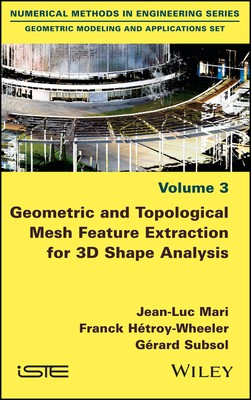
- We will send in 10–14 business days.
- Author: Franck Hétroy-Wheeler
- Publisher: Wiley-ISTE
- ISBN-10: 1786300419
- ISBN-13: 9781786300416
- Format: 15.2 x 22.9 x 1.3 cm, kieti viršeliai
- Language: English
- SAVE -10% with code: EXTRA
Geometric and Topological Mesh Feature Extraction for 3D Shape Analysis (e-book) (used book) | bookbook.eu
Reviews
Description
Three-dimensional surface meshes are the most common discrete representation of the exterior of a virtual shape. Extracting relevant geometric or topological features from them can simplify the way objects are looked at, help with their recognition, and facilitate description and categorization according to specific criteria. This book adopts the point of view of discrete mathematics, the aim of which is to propose discrete counterparts to concepts mathematically defined in continuous terms. It explains how standard geometric and topological notions of surfaces can be calculated and computed on a 3D surface mesh, as well as their use for shape analysis. Several applications are also detailed, demonstrating that each of them requires specific adjustments to fit with generic approaches. The book is intended not only for students, researchers and engineers in computer science and shape analysis, but also numerical geologists, anthropologists, biologists and other scientists looking for practical solutions to their shape analysis, understanding or recognition problems.
EXTRA 10 % discount with code: EXTRA
The promotion ends in 22d.12:28:55
The discount code is valid when purchasing from 10 €. Discounts do not stack.
- Author: Franck Hétroy-Wheeler
- Publisher: Wiley-ISTE
- ISBN-10: 1786300419
- ISBN-13: 9781786300416
- Format: 15.2 x 22.9 x 1.3 cm, kieti viršeliai
- Language: English English
Three-dimensional surface meshes are the most common discrete representation of the exterior of a virtual shape. Extracting relevant geometric or topological features from them can simplify the way objects are looked at, help with their recognition, and facilitate description and categorization according to specific criteria. This book adopts the point of view of discrete mathematics, the aim of which is to propose discrete counterparts to concepts mathematically defined in continuous terms. It explains how standard geometric and topological notions of surfaces can be calculated and computed on a 3D surface mesh, as well as their use for shape analysis. Several applications are also detailed, demonstrating that each of them requires specific adjustments to fit with generic approaches. The book is intended not only for students, researchers and engineers in computer science and shape analysis, but also numerical geologists, anthropologists, biologists and other scientists looking for practical solutions to their shape analysis, understanding or recognition problems.


Reviews